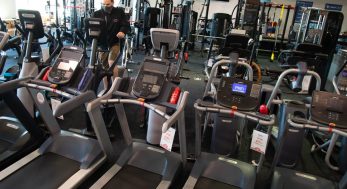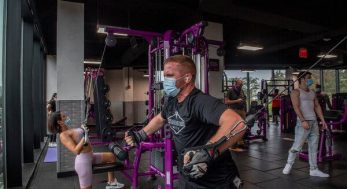TOKYO—Exercise buff Yukie Watabe just about had it when she went to her fitness club and found older women using the bench-press machine as an actual bench.
The women were chatting about how to pickle vegetables at home—a worthy subject for the health-conscious, no doubt, but not quite the vibe Ms. Watabe was looking for.
“I complained a couple of times to the staff there. But it seemed they prioritized” the elderly clientele, said Ms. Watabe, 46 years old. She quit the club and now jogs with her husband.
Japan’s retired people are taking over establishments traditionally associated with youth and sculpted bodies. The gym of the future, as seen in a country where nearly 30% of the population is over 65, features tai chi classes, lengthy soaks in hot baths and plenty of socializing among folks who have no business meetings to rush back to.
One recent morning, more than a dozen elderly men and women gathered at the entrance of a Tokyo outlet of fitness club operator Renaissance Co., chatting about their medicines and a serial drama on public TV. As they waited for the 10 a.m. opening, an old woman passed by, hunched over a small cart to support herself. The club members greeted her, a former gym friend.

Soon 91-year-old Taeko Shimodaira arrived, and a younger woman helped her climb a few steps to the entrance porch and settle on a bench there. Ms. Shimodaira comes to the club every day.
“When people stop seeing me here, it means I’ve gone,” she said.
When the doors opened, 77-year-old Kuniko Kikuchi headed to the locker room to change for her 10:15 tai chi class. She used the bottom locker. “It’s hard for me to reach the top one,” Ms. Kikuchi said, pointing to her slightly curved back.
After a walk on the treadmill or dip in the pool, many club members repair to a hot bath—a centuries-old form of relaxation in Japan. On another recent day, Ms. Kikuchi spent hours there and played hooky from her swimming class.
“I got so wrapped up in talking,” she said. “But I walked in the water on my own.”

For gym goers in Japan, soaking in a bath is the second most popular activity after working out on machines, according to a survey by a marketing unit of phone company NTT DoCoMo Inc.
Share Your Thoughts
You’ve hit 75 years old. What’s your health-club routine? Join the conversation below.
At Renaissance, only 3% of members were over 60 a quarter-century ago. Today, one in three are in that category and, depending on the location and time of the day, the customers are nearly all elderly, said a spokeswoman.
Programs at Renaissance gyms include stretching classes to prevent back pain and brain exercises to keep aging minds sharp. It and other chains are adding features for the elderly such as massage chairs and steps into the pool instead of metal ladders.
Yoshihiko Kato, a 49-year-old factory worker in Tokyo, recently quit his fitness club and switched to Anytime Fitness, a Minnesota-based chain with outlets in Japan. It appeals to a younger crowd with 24-hour service and a focus on fitness machines rather than amenities for relaxing.
“I’m going to get old too, so I don’t want to complain,” said Mr. Kato. At his previous club, he said, “I was a bit annoyed at how a group of old people were chatting nonstop.”
For gym operators, elderly members have helped tone up the bottom line. Japan’s fitness industry in 2018 posted a record $4.4 billion in revenue, and government figures show more than half of that comes from people over 60, who tend to buy pricier full memberships.

Japan’s life expectancy, at 87 years for women and 81 for men, is among the highest in the world. Studies suggest the average Japanese person’s number of years in good health is roughly a decade shorter than life expectancy. The government, seeking to tame medical costs, is encouraging exercise and aims to extend the healthy lifespan by three years by 2040.
Curves, a women-only gym, originally started in the U.S. targeting busy mothers and working women. In Japan, it is one of the fastest-growing sports clubs, with 850,000 members. Japanese people sometimes call it a gym for “obaachan,” or grandmas, who pay some $50 to $60 a month. The average Japanese member is 64, and the oldest member, 101 years old, comes to the gym regularly with her septuagenarian daughter, said a Curves spokeswoman.
Takeshi Masumoto, who started out running Curves franchising in Japan and now controls the Curves brand globally, said the company’s main marketing tool in Japan was getting older members to introduce their friends. “Given their age, they don’t search around online. They don’t trust TV ads,” he said.
Saiko Osawa, 85, is one of those Curves is counting on as a walking advertisement. She joined five years ago. “I used to fall often. But I have not fallen even once for the past couple of years,” she said. “I don’t want to be bedridden.”
The word-of-mouth strategy has its limits. Encountering the manager of her club recently, Ms. Osawa apologized for not being much help. “Most of my friends are now at homes for the elderly,” she said.

Write to Miho Inada at miho.inada@wsj.com
Correction
The first name of Takeshi Masumoto was incorrectly given as Takeru in an earlier version of this article. (Jan. 15, 2020)
Copyright ©2019 Dow Jones & Company, Inc. All Rights Reserved. 87990cbe856818d5eddac44c7b1cdeb8

